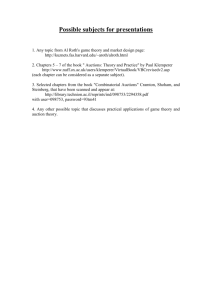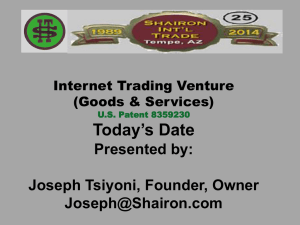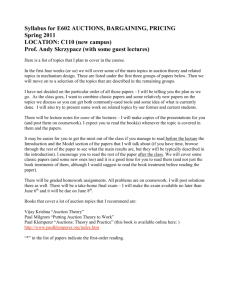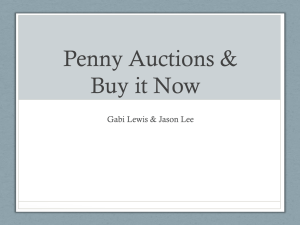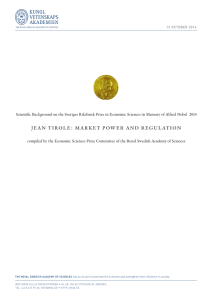industrial organization
advertisement
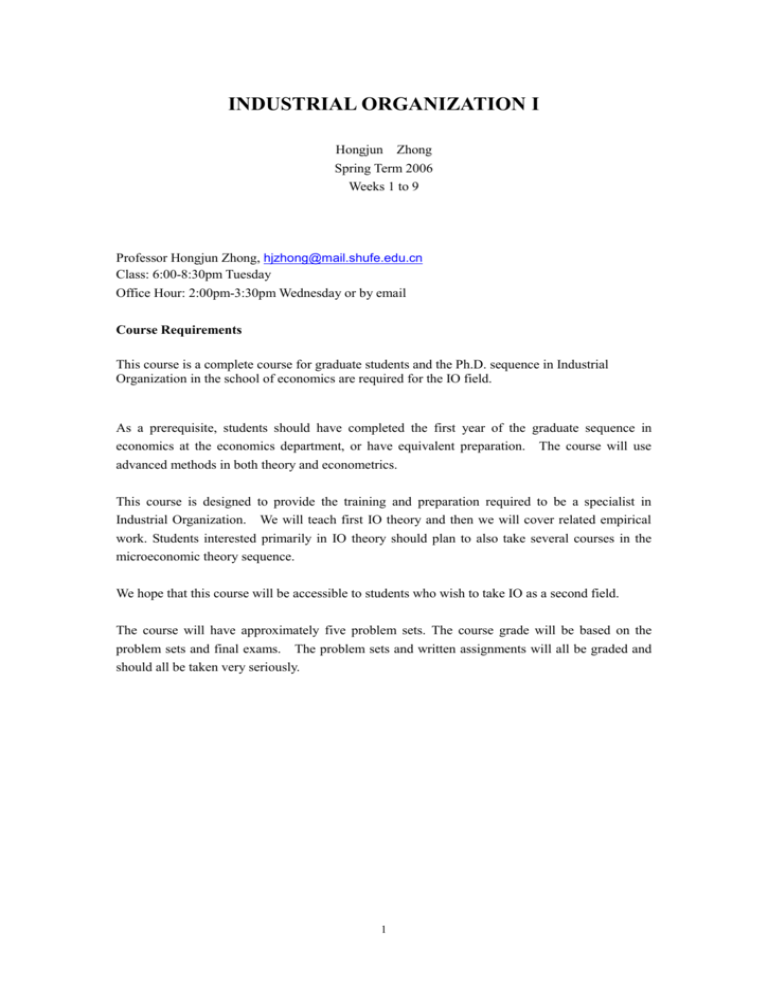
INDUSTRIAL ORGANIZATION I Hongjun Zhong Spring Term 2006 Weeks 1 to 9 Professor Hongjun Zhong, hjzhong@mail.shufe.edu.cn Class: 6:00-8:30pm Tuesday Office Hour: 2:00pm-3:30pm Wednesday or by email Course Requirements This course is a complete course for graduate students and the Ph.D. sequence in Industrial Organization in the school of economics are required for the IO field. As a prerequisite, students should have completed the first year of the graduate sequence in economics at the economics department, or have equivalent preparation. The course will use advanced methods in both theory and econometrics. This course is designed to provide the training and preparation required to be a specialist in Industrial Organization. We will teach first IO theory and then we will cover related empirical work. Students interested primarily in IO theory should plan to also take several courses in the microeconomic theory sequence. We hope that this course will be accessible to students who wish to take IO as a second field. The course will have approximately five problem sets. The course grade will be based on the problem sets and final exams. The problem sets and written assignments will all be graded and should all be taken very seriously. 1 Readings Required Textbook TIROLE, J., The Theory of Industrial Organization, MIT Press, 1988 (泰勒尔著(张维迎校译) , 《产业组织理论》,中国人民大学出版社。 ) MOTTA, M., Competition Policy: Theory and Practice, Cambridge University Press, 2004. Useful books: 1) Vives, Xavier, Oligopoly Pricing, MIT Press, 1999. 2) SCHMALENSEE, R. and WILLIG, R., eds., Handbook of Industrial Organization, North Holland, 1989. 3) Advanced Industrial Economics by Stephen Martin/高级产业经济学,马丁,上海财经大 学出版社。 4) 柯伦伯著(钟鸿钧译) , 《拍卖:理论与实践》 ,中国人民大学出版社。 5) 沃尔夫斯泰特著(范翠红译),《微观经济学专题:产业经济学,拍卖与激励理论》,上海 财经大学出版社。 Topics 1. Oligopoly Theory (a) Cournot and Bertrand. TIROLE, pages 209-224. (b) Cooperation in repeated games. TIROLE, pages 239-264, 268-269. (c) Product differentiation TIROLE, pages 277-285, 296-300. (d) Price competition vs Quantity competition SHAPIRO, C. Theories of Oligopoly Behavior, in Schmalensee and Willig, eds., especially pages 348-352. 2. Entry, exit and Strategic Behavior (a) Entry and welfare, wars of attrition, entry barriers, contestability. TIROLE, pages 305-313 ARMSTRONG, M., COWAN, S., AND VICKERS, J. Regulatory Reform: Economic Analysis and the British Experience. MIT Press, Cambridge and London, 1994, pages 106-111. BAUMOL, W. Contestable Markets: 'An Uprising in the Theory of Industry Structure'. American Economic Review (1982), 1-15. (b) Strategic investment and entry deterrence and accommodation. TIROLE, pages 207-208, 314-337 BULOW, J. I., GEANAKOPLOS, J. D., AND KLEMPERER, P. D. Multimarket oligopoly: Strategic substitutes and complements. Journal of Political Economy 93, 3 (June 1985), 488-511. DIXIT, A. K. The role of investment in entry-deterrence. Economic Journal 90 (March 1980), 2 95-106. SHAPIRO, C. Theories of Oligopoly Behavior. In Schmalensee and Willig, eds., especially pages 381-397. (c) Information and Strategic behaviour: Limit pricing and predatory pricing TIROLE, pages 361-380. MILGROM, P., AND ROBERTS, J. Limit pricing and entry under incomplete information: An equilibrium analysis. Econometrica 50, 2 (March 1982), 443-459. (d) Exit FUDENBERG, J AND TIROLE, A Theory of Exit in Duopoly 3. Pricing 3.1 Price Discriminination *Tirole, ch. 3. Milgrom, P., and Segal, I., 2000, “Envelope Theorems,” Econometrica, 70, 583-601 (pdf in: http://www-econ.stanford.edu/faculty/segal homepage.html). Varian, H., ”Price Discrimination,” Handbook. *Varian, H., 1985 ”Price Discrimination and Social Welfare,” AER, 870-75. Holmes, T., 1989, ”The Effects of Third-Degree Price Discrimination in Oligopoly,” AER, 244-50. Katz, M., 1987, ”The Welfare Effects of Third-Degree Price Discrimination in Intermediate Goods Markets,” AER, 154-67. *Maskin and Riley, 1984, ”Monopoly with Incomplete Information,” RJ, Summer, 171-96. Stole, 1992, ”Oligopoly and Product Quality,” mimeo, University of Chicago. Gale and Holmes, 1992, ”Advance-Purchase Discounts and Monopoly Allocation of Capacity,” AER. Che and Gale, 2000, ”The Optimal Mechanism for Selling to Budget-Constrained Consumers,” JET, 92, 198-233. * Whinston, 1990, ”Tying, Foreclosure, and Exclusion” AER, 837-859. 3.2 Price Dispersion, Search, and Switching Costs Baye, M. and J. Morgan, “Information Gatekeepers on the Internet and the Competitiveness of Homogeneous Product Markets,” Mimeo, Princeton University, 2001. http://www.princeton.edu/~rjmorgan/gatekeepers.pdf Klemperer, P., “The Competitiveness of Markets with Switching Costs,” RAND Journal ofEconomics, 18 (1), Spring 1987, 137-50. Klemperer, P., “Markets with Consumer Switching Costs,” Quarterly Journal of Economics, 102(2), May 1987, 375-94. 3 Klemperer, P., “Competition When Consumers Have Switching Costs: An Overview with Applications to Industrial Organization, Macroeconomics, and International Trade,” Review of Economic Studies 62 (4), October 1995, 515-39. Stahl, D., “Oligopolistic Pricing with Heterogeneous Consumer Search,” International Journal of Industrial Organization, 14 (April 1996), 243-268. Varian, H., “A Model of Sales,” American Economic Review 70 (4), September 1980, 651-59. 4. Auctions Theory and Procurement KLEMPERER, P., Auctions: Theory and Practice. Princeton University Press. 柯伦伯, 《拍卖:理论与实践》 ,中国人民大学出版社。(钟鸿钧译) University Discussion Paper, available at www.nuff.ox.ac.uk/economics/people/klemperer.htm 4.1 Basic (IPV) Setting McAfee P. and J. McMillan, 1987, Auctions and Bidding, Journal of Economic Literature, 25: 669-738. *Milgrom, P.R., 1989, ”Auctions and Bidding: A Primer,” Journal of Economic Perspectives, 3:3-22. * Myerson, R. 1981, ”Optimal Auction Design,” Mathematics of Operations Research, 6: 58-73. Klemperer, P., 1999, “Auction Theory: A Guide to the Literature, Journal of Economic Survey, 13,227-286. 4.2 Affiliation and Winner’s Curse * Milgrom, P.R., 1989, ”Auctions and Bidding: A Primer,” Journal of Economic Perspectives, 3: 3-22. * Milgrom P.R. and Weber, R., 1982, “A Theory of Auctions and Competitive Bidding,” 50, 1089-1122. Milgrom P.R., 1987, “Auctions Theory,” in Advances in Economic Theory: Fifth World Congress.(Truman Bewley Ed.) Cambridge: Cambridge Press. 4.3 Auctioning (Procurement) Contracts Laffont and Tirole, 1987, “Auctioning Incentive Contracts,” JPE. 95: 921-937. Riordan, M. and Sappington, D., 1987, ”Awarding Monopoly Franchises,” AER. 77: 375-87. McAfee and McMillan, 1986, ”Bidding for Contracts: A Principal-Agent Analysis,” RJE., 17: 326-338. * Che, 1993, ”Design Competition through Multidimensional Auctions,” RJ, Winter. 4.4 Auctions with Budget Constraints Che and Gale, 1997, “Standard Auctions with Financially-Constrained Bidders,” RES, 65: 1-21. * Maskin, E., 2000, “Auctions, Development, and Privatization: Efficient Auctions with Liquidity Constrained Buyers,” (Alfred Marshall Lecture), EER, 44, 667-681. 4.5 Auctions with Corruption McAfee and McMillan, 1992, “Bidding Rings,” AER. 82: 579-599. 4 Burguet and Che, 2000, “Competitive Procurement with Corruption,” mimeo, (in http://www.ssc.wisc.edu/ yche/corrupt.pdf). 4.6 Auctions with Entry McAfee and McMillan, 1987, “Auctions with Entry,” Economics Letters, 23, 343-47. Levin and Smith, 1994, ”Equilibrium in Auctions with Entry,” AER, 585-599. 4.7 Multiunit Auctions Milgrom, P.R., 2000, “Putting Auction Theory to Work: Simultaneous Ascending Auction,” JPE, April. * Ausubel, L., 1997, “Efficient Ascending-Bid Auction for Multiple Objects,” mimeo, (in http://www.ausubel.com/auction-papers/efficient-ascending-auction-r.pdf) Ausubel, L., and Cramton, P., 1998, “Demand Reduction and Inefficiency in Multiunit Auctions,” mimeo, (pdf in http://www.ausubel.com/auction-papers/demand-reduction-r.pdf) Jehiel, P., and Moldovanu, B., 1998, “Efficient Design with Interdependent Valuations,” mimeo, (in http://www.vwl.uni-mannheim.de/moldovan/papers/fineff3.pdf). Perry, M., and Reny, P., 2000, “An Ex Post Efficient Auction,” (in http://www.vwl.uni-mannheim.de/moldovan/conference/). 4.8. Internet Auction and Buy-price. David Lucking Riley, A Survey on Internet Auction, Journal of Industrial Economics, 2000 Lou Xing and H. Zhong, When to use buy-price auction, mimeo, Oxford University/SUFE. 5. Regulation Armstrong, Mark and David Sappington, Recent developments in regulation theory Laffont & Tirole, A Theory of Incentives in Procurement and Regulation, 1993. 5
